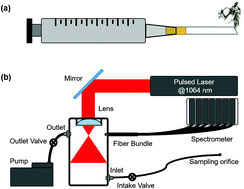On-line detection of radioactive and non-radioactive heavy metals in tobacco smoke using portable laser-induced breakdown spectroscopy
Abstract
Tobacco smoke is a complex mixture consisting of hundreds of toxic and carcinogenic chemicals, which may cause many diseases once inhaled. Among these toxic substances, radioactive and non-radioactive heavy metals present great health concerns to both active and passive smokers. However, conventional methodologies for characterizing heavy metals in smoke require intensive and time-consuming preparation procedures, and thus prevent their on-line applications. We report here a portable laser-induced breakdown spectroscopy (PLIBS) device for on-line detection of radioactive and non-radioactive heavy metals in tobacco smoke with ultra-high sensitivity. Two local cigarette brands were investigated, and a number of heavy metals were detected. In particular, several radioactive metals show very strong atomic emissions, and a limit of detection down to parts per trillion was obtained by single-shot PLIBS. The linear dependencies of their spectral intensities on the smoke concentrations were revealed, suggesting that the PLIBS is a promising tool for high-throughput and quantitative analysis of heavy metals in tobacco smoke. Tobacco emission dynamics were also investigated, and the results suggest the potential applications of the PLIBS in smoke risk assessment.



 Please wait while we load your content...
Please wait while we load your content...